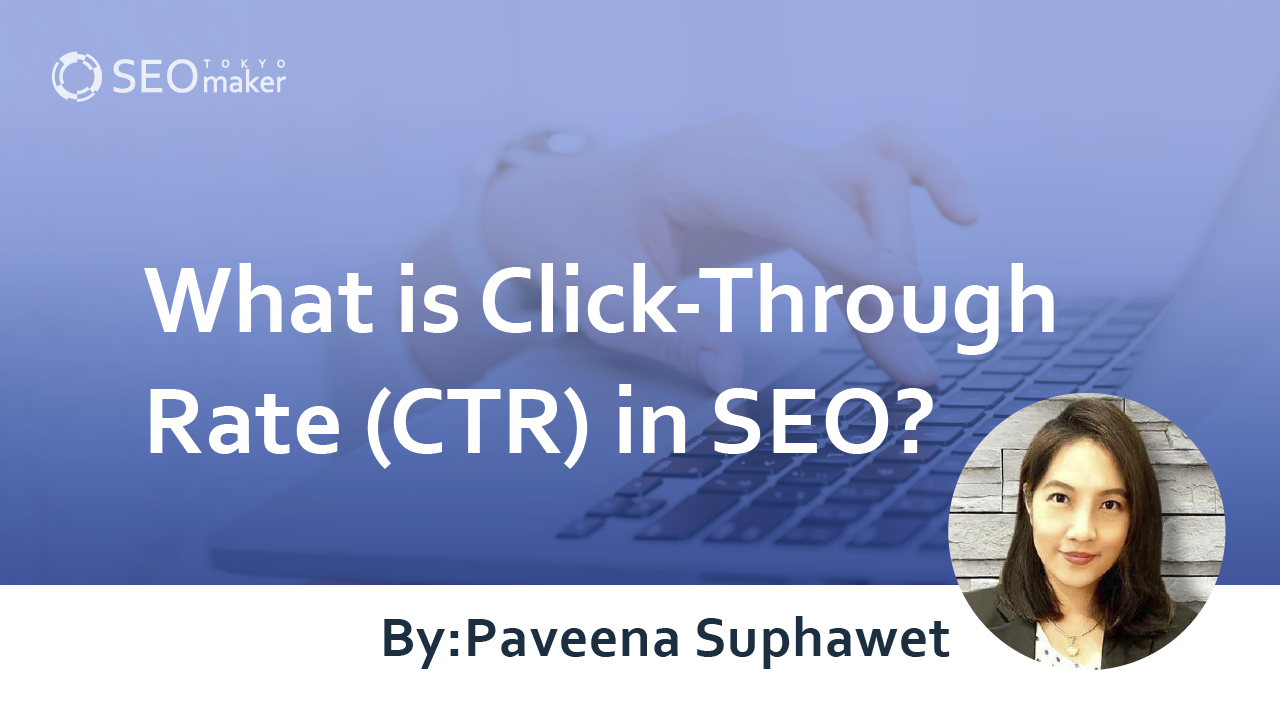What is Click-Through Rate (CTR)? : Introducing CTR by Ranking
contents
- 1 What is Click-Through Rate (CTR) in SEO?
- 2 How to Calculate Click-Through Rate (CTR)
- 3 The Relationship Between SEO Search Rankings and CTR
- 4 Click-Through Rate (CTR) for Listing Ads is 3.1%
- 5 CTR Varies by Keyword
- 6 Factors Influencing SEO CTR
- 7 How to Check SEO CTR
- 8 Methods to Improve SEO Click-Through Rate (CTR)
- 9 Summary

The goal of aiming for higher rankings in SEO is to improve the click-through rate (CTR), which in turn increases site traffic. Understanding the relationship between search results and CTR helps clarify the importance of achieving higher rankings in SEO.
This time I will explain the overview of CTR in SEO, its relationship with search rankings, and methods for improvement.
What is Click-Through Rate (CTR) in SEO?
In SEO, click-through rate (CTR) refers to the probability that users will click on your site’s snippet displayed in search results. A high CTR indicates that your site’s content is high-quality and meets the user’s search intent, serving as a metric for site evaluation.
Conversely, a low CTR suggests the need to improve the snippet displayed in search results or the content itself.
How to Calculate Click-Through Rate (CTR)
In SEO, CTR is calculated by dividing the number of clicks by the number of impressions (times your snippet is displayed). The formula is as follows.
CTR = (Number of Clicks / Number of Impressions)
When using CTR as an SEO KPI, it’s important to quantitatively follow the PDCA cycle based on this calculation.
The Relationship Between SEO Search Rankings and CTR
Higher SEO rankings generally correlate with higher CTR. However, you might wonder how significant the difference in CTR can be across rankings. Let’s explore the relationship between CTR and SEO rankings.
Average CTR by Search Ranking
|
Search Ranking |
CTR |
|
1st |
28.5% |
|
2nd |
15.7% |
|
3rd |
11.0% |
|
4th |
8.0% |
|
5th |
7.2% |
|
6th |
5.1% |
|
7th |
4.0% |
|
8th |
3.2% |
|
9th |
2.8% |
|
10th |
2.5% |
Source: Why (almost) everything you knew about Google CTR is no longer valid
From this chart, we see that the CTR is 28.5% for the 1st position, 7.2% for the 5th position, and 2.5% for the 10th position. The difference between the 1st and 5th positions is significant.
|
Search Ranking |
1st |
5th |
10th |
|
Impressions |
10,000 |
10,000 |
10,000 |
|
CTR |
28.5% |
7.2% |
2.5% |
|
Clicks |
2,850 |
720 |
250 |
Assuming a keyword with 10,000 impressions (different from search volume), this comparison illustrates the substantial difference in traffic based on CTR.
Click-Through Rate (CTR) for Listing Ads is 3.1%
Let’s also look at the click-through rate (CTR) for listing ads, which are often used alongside SEO. Although CTR varies by industry, the overall industry average is approximately 3.1%.
Despite differences depending on the product or service, this highlights the importance of SEO as a channel.
Reference Article: Google Ads Benchmarks for YOUR Industry
CTR Varies by Keyword
CTR in SEO varies significantly depending on the target keyword. Here are four key factors where CTR differs.
♦Keyword category
POINT
- Brand keywords
- Number of keywords
- Search intent
- Area or genre
Let’s look at the characteristics of each and compare them with your products or services.
Brand Keywords
Brand keywords refer to highly recognized keywords such as product or service names and company names. Brand keywords tend to have higher CTR compared to non-brand keywords due to their reliability and recognition.
Particularly, the CTR for the top 1-2 positions of brand keywords tends to be higher. This is because searches for brand keywords often generate two snippets for the official site.
Number of Keywords
More keywords tend to result in a higher CTR. In SEO, searches with multiple keywords clarify user needs more than single-word searches.
For example, the search intent is clearer for users who search “SEO strategies book” compared to those who simply search “SEO.” Users searching “SEO strategies book” are likely looking for books to help with SEO strategies, whereas users searching “SEO” may have various reasons, such as wanting to learn the basics or looking to implement SEO tactics.
Search Intent
CTR also varies based on the search intent of keywords. Search intent refers to the purpose behind a user’s search.
Generally, keywords with purchasing intent tend to have higher CTRs than informational search keywords.
Examples of purchasing intent keywords include “buy MacBook” and “compare English conversation schools.” On the other hand, examples of informational search keywords include “what is tax obligation” and “height of Tokyo Tower.”
This is because users searching for purchasing intent keywords are often looking to take immediate action (e.g., making a purchase).
Area or Genre
CTR also differs based on the area or genre of the keyword. Keywords related to e-commerce or complex issues, which likely attract users with high purchasing intent, tend to have higher CTRs.
Factors Influencing SEO CTR
While search rankings are said to impact SEO CTR, many other factors also play a role. Among these, the following two elements are highly influential.
POINT
- Page title
- Meta description content
The page title, which appears at the top of the snippet in search results, serves as the “face” of the page content and is a key factor in determining whether users click.
The meta description, though less prominent than the page title, plays a significant role in influencing users’ decisions before they click.
How to Check SEO CTR
To check CTR in SEO, you can use the Google Search Console. By selecting “Search Performance” from the left menu in Google Search Console, you can view CTR data for each keyword and landing page.
While Google Search Console only provides information about traffic from Google, it’s generally acceptable to disregard traffic from Yahoo! or Bing, as it is usually minimal.
What is Google Search Console? How to Set Up and Use It
Methods to Improve SEO Click-Through Rate (CTR)
Google’s search results dynamically change based on Google’s algorithm. Therefore, it is essential to continuously work on improving SEO CTR. Here are three methods to enhance CTR.
POINT
- Create an attractive page title
- Set a meta description
- Set up featured snippets
Create an Attractive Page Title
The page title is located at the very top of each snippet in the search results, making it the most noticeable and important information that users will see when deciding whether to view the page.
Thus, creating an attractive page title can lead to improved CTR. Here are the attractive titles.
- Information that the user is looking for
- Keywords placed near the beginning of the title
- Words that make the content seem interesting
>> Effective Ways to Create SEO Titles | Misunderstood Title Tags
et a Meta Description
A meta description is the text displayed below the page title in search results. It is used by users to determine whether the page content is worth clicking on.
The meta description should include SEO target keywords as early as possible and address the user’s search needs.
Set Up Featured Snippets
Featured snippets are answer boxes displayed at the top of Google’s search results. Setting up featured snippets can increase the space your snippet occupies and improve CTR.
To have your page’s snippet appear as a featured snippet in Google’s search results, aim for a high ranking, provide concise answers in short sentences, and use proper HTML markup.
>>What is featured snippet?
Summary
We have discussed the overview of CTR in SEO, its relationship with search rankings, and methods for improvement. In SEO, it is easy to focus on site structure and page content, but understanding and regularly improving the elements that contribute to CTR in search results is key to success. If you are beginning SEO efforts, prioritize improving CTR and work towards enhancing your site.










![What is a Description? Explaining the Meaning, Writing Style, and Changing Word Count – [2023 Edition]](https://www.switchitmaker2.com/en/wp-content/uploads/2024/09/what-is-description.webp)










